Tessa’s Recipe Rundown
TASTE: Perfectly rich and chocolatey, without being overly sweet.
TEXTURE: Incredibly smooth, creamy, and luscious.
EASE: There’s one more step beyond a regular American-style buttercream, but I promise, it’s 100% worth the little extra work.
PROS: Instantly improves any cake, cupcake, or pretty much any other dessert.
CONS: None!
WOULD I MAKE THIS AGAIN? I have made this recipe countless times!
This post may contain affiliate links. Read our disclosure policy.
This buttercream truly lives up to the name ‘Best Ever Chocolate Buttercream Frosting’.
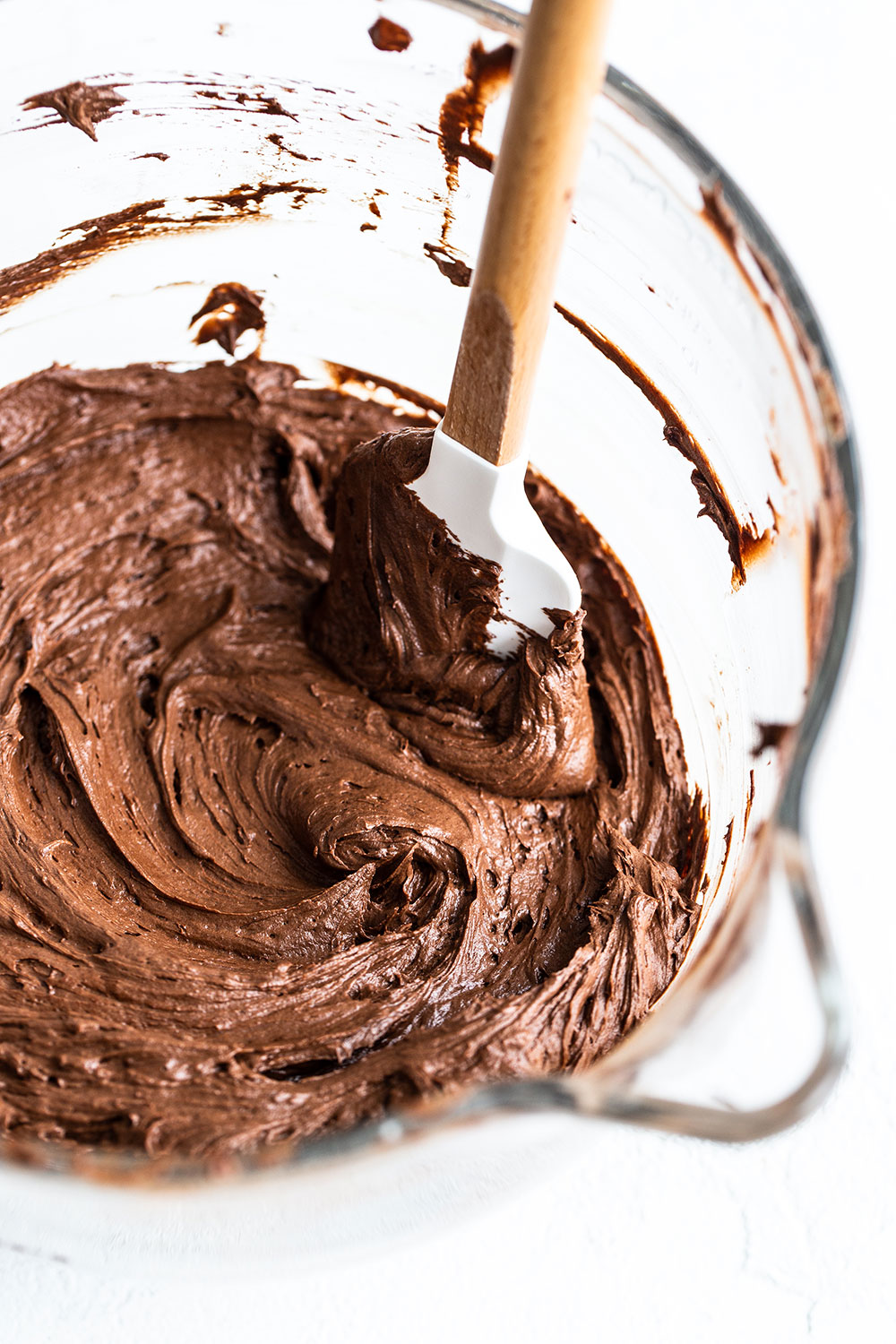
If we’re being honest, American buttercream often leaves a lot to be desired. It’s typically cloyingly sweet and sugary, with a discernible grittiness from the powdered sugar.
Compared to the ultra-smooth silkiness of Swiss Meringue Buttercream or Italian Meringue Buttercream, American buttercream usually just pales in comparison.
Although nothing will quite compare to Swiss or Italian Meringue Buttercream … I think I’ve discovered the next best option.
It’s an American-style buttercream that uses one simple technique and two secret ingredients to get that rich, smooth, creamy, velvety, silky texture and strong chocolate flavor, without nearly as much work.
I have to give credit to the amazing Stella Parks for her genius that is this buttercream recipe.
Learn the secrets to this Best Ever Best Ever Chocolate Buttercream Frosting below, and learn all my best tips and tricks in the pink tip box below!
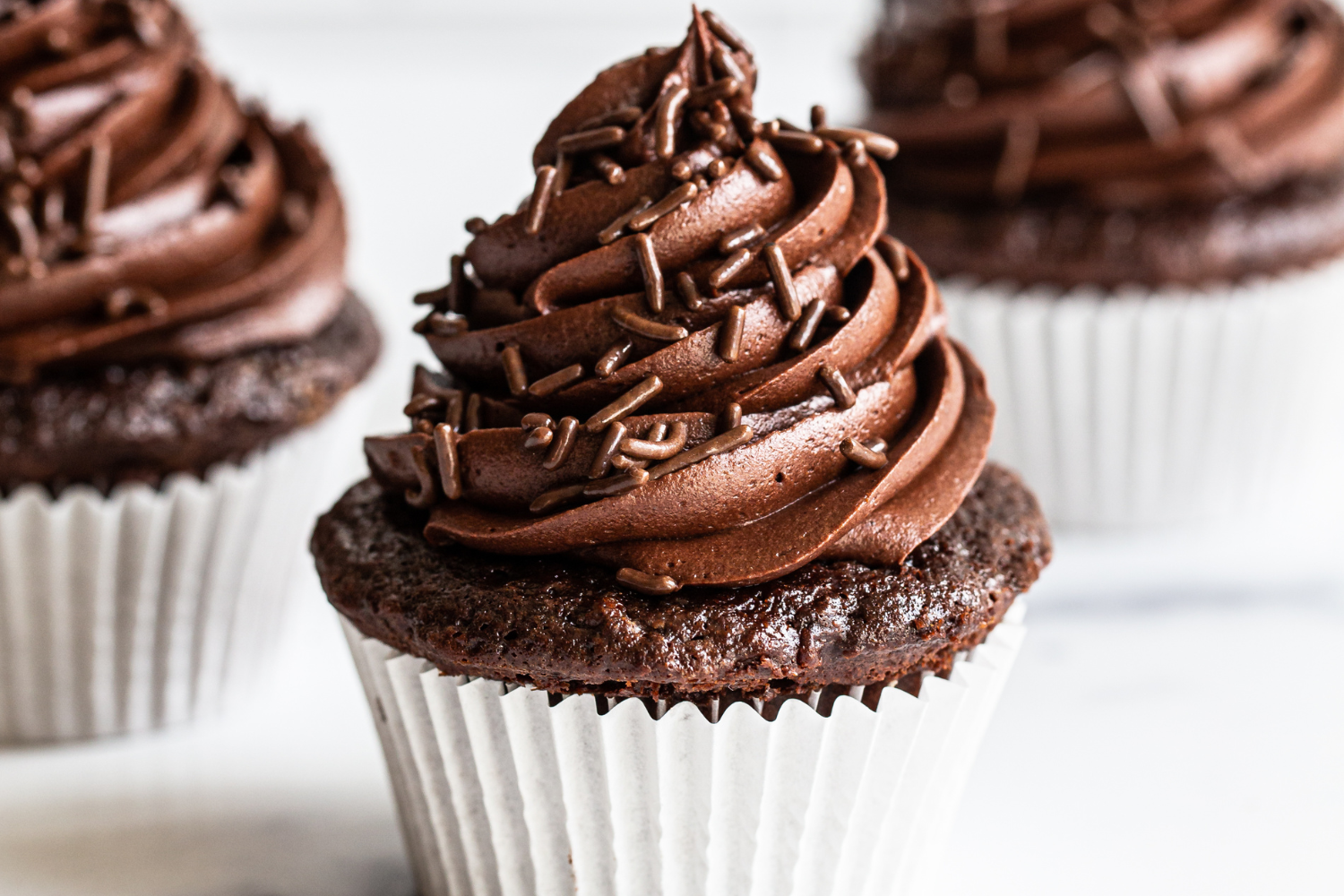
How to Make the BEST Chocolate Buttercream Frosting
The Secrets to the Best Ever Chocolate Buttercream Frosting
- Ganache: Add a small amount of cooled (but not chilled) chocolate ganache to the buttercream. This magic combo of heavy cream + melted chocolate lends intense fudgy richness to the American buttercream texture and a huge dose of chocolate flavor.
- High Fat Cocoa Powder + Organic Powdered Sugar: More on these magical ingredients, and where to find them, below.
Why Add Chocolate Ganache to Buttercream?
In some of my chocolate buttercream recipes, I simply add cocoa powder. In others, I’ll also add some melted chocolate. But thanks to Stella Parks, I now know the best way to get chocolate flavor AND fudgy texture is by adding in ganache! A small amount, just enough to pack a punch without making the buttercream too dense.
There are two keys to adding ganache to your buttercream:
- Avoid using chocolate chips. Instead, chop up a bar of your favorite semi-sweet baking chocolate. Chocolate chips have emulsifiers and stabilizers that maintain that chip shape even after being exposed to heat, so they simply don’t melt down as smooth and creamy.
- The ganache needs to be at just the right temperature before adding to the frosting. What’s the right temp? Room temp, about 75°F. It should be thick but still somewhat pourable. Too hot and it’ll melt the butter. Too cold and it’ll harden.
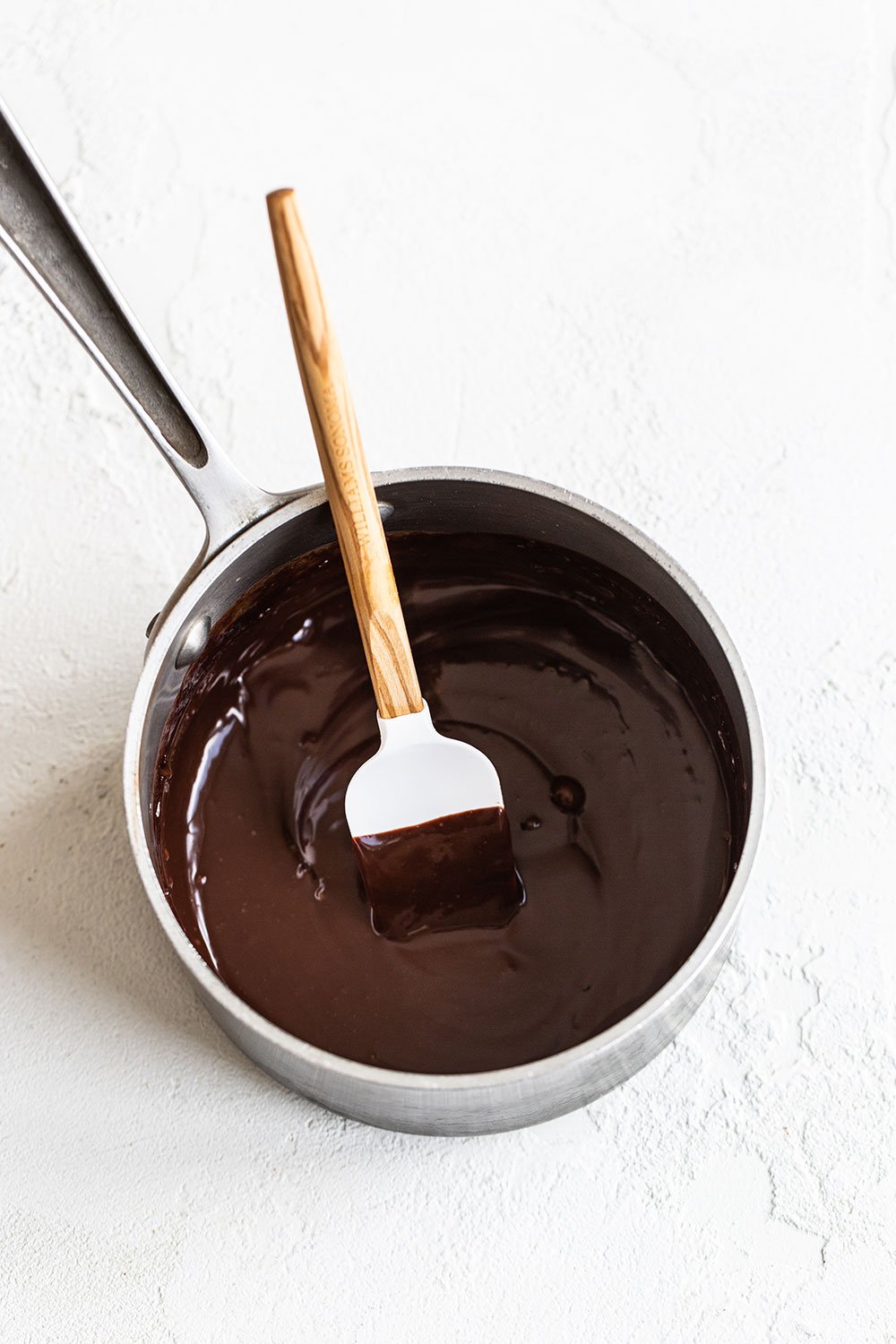
The Best Powdered Sugar for Buttercream is ORGANIC
- Organic powdered sugar is made with tapioca starch to prevent caking. Organic powdered sugar is perfect for any instance you want the sugar to dissolve smoothly (which means it would be awful for using as a decorative garnish).
- Conventional powdered sugar is made with cornstarch to prevent caking.
- Tapioca starch is not only sweeter than cornstarch, but it dissolves better into buttercream. Less chalky gritness.
- Whatever you do, DON’T SKIP SIFTING! Especially if using organic powdered sugar, which gets ultra clumpy.
Where to buy organic powdered sugar?
Trader Joe’s sells it under its own name. The brand Wholesome is the other most widely available option here in the US. Use their store locator to find where they stock near you. Alternatively, buy it on Amazon here.
Do I HAVE to use organic powdered sugar?
No – but it’s these little things that add up to take your baking from good to WOW. If you’re using conventional powdered sugar, just make sure it’s finely ground 10x (not 6x which is for decorating).
HIGH-FAT Dutch Process Cocoa is MAGIC!
Seriously.
Most cocoa powder you find at the grocery store is starchy. For a fun test, the next time you’re at the store turn all the cocoa powder containers around to compare their nutrition facts. You’ll see the amount of fat will vary by brand. High-fat cocoa powder has between 22-24% fat, whereas most grocery store brands have half that amount. This means they’re literally more drying. If you ever have a problem with dry chocolate cake, cupcakes, or brownies, take a peek at your cocoa powder’s fat percentage.
Why Dutch process? Because its acidity has been neutralized and tends to be of high quality since it’s a specialty product. This matters that much more when it’s going into a raw preparation like buttercream. Learn more about Natural vs. Dutch Processed Cocoa Powders here.
Where to buy high-fat Dutch process cocoa?
I know you’re probably thinking that just finding Dutch process cocoa is challenging enough. Here are some options for getting your hands on this magical cocoa:
Be Sure Your Butter is at the Right Temperature!
When making any kind of American buttercream, you want to be sure your butter is at a COOL room temperature. It should not be so warm that it looks and feels oily and greasy because guess what… that’s exactly how the buttercream will turn out. Which also makes it more difficult to work with on cakes & cupcakes.
Why does my buttercream taste like BUTTER?
Well… because there’s a ton of butter in it haha! It’s in the name after all. But if you notice this in an unpleasant way, try switching brands of butter. Also, always use unsalted butter in buttercream. Not only does this allow you to control the amount of salt, but unsalted is generally fresher because salt acts as a preservative in salted butter, giving it a longer shelf life. Learn more about Salted vs. Unsalted Butter here.
How Long Should I Beat My Buttercream?
- It’s so important to use your mixer correctly. Below, the image on the left shows barely beaten frosting, and the image on the right shows frosting beaten for several minutes.
- The longer you beat your buttercream, the more air you’ll whip into it, and the lighter and smoother it’ll be.
- For my mixer, the total beating time is about 5 minutes. That doesn’t include stopping to scrape down the sides sides and bottom of the bowl and your paddle attachment. The exact timing will depend on your mixer.
- You’re looking more for visual indicators. The final buttercream should be lighter in color than when you started. It should look and taste smooth and creamy and be easy to spread.
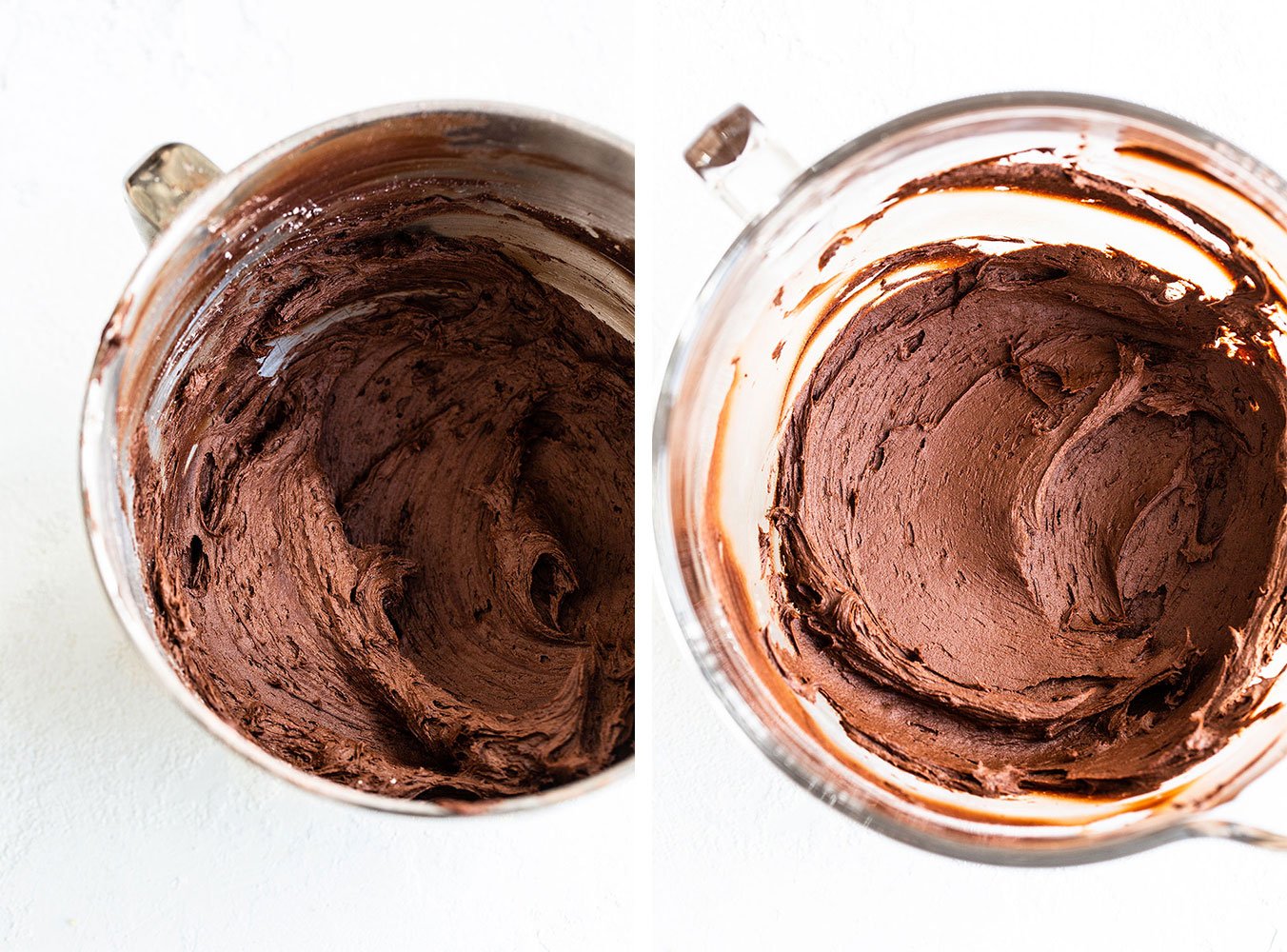
Can You Freeze Buttercream?
Yes! Store in an airtight container in the freezer for up to 3 months. Let come to room temperature and re-whip in the stand mixer until light and fluffy again. Add a tablespoon or 2 of powdered sugar if it needs to thicken.
How to Store Buttercream
Transfer to an airtight container and store in the fridge for up to a week. Let come to room temperature and re-whip in the stand mixer until light and fluffy again. Add a tablespoon or 2 of powdered sugar if it needs to thicken.
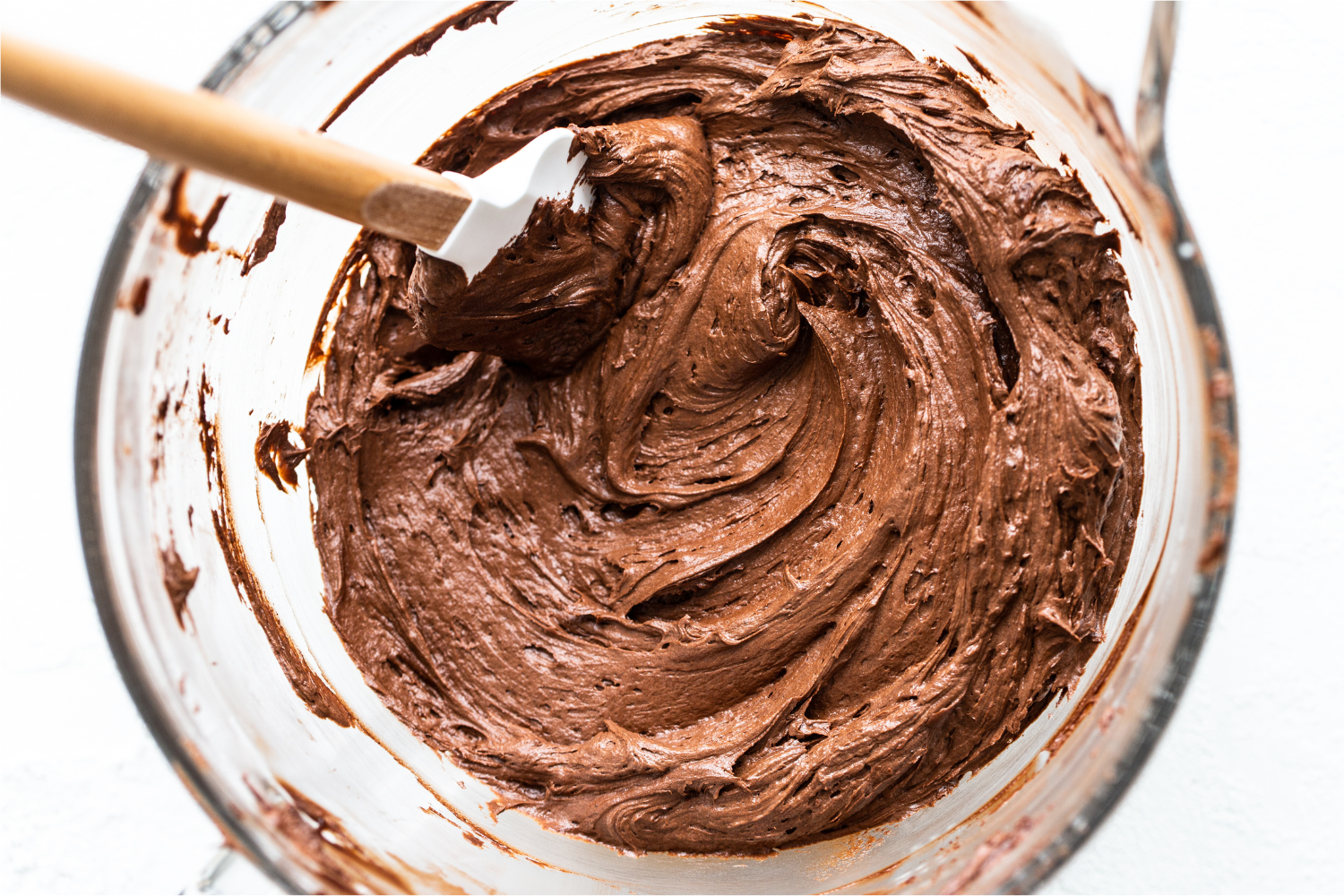
Ways to use this Chocolate Buttercream Frosting:
- Chewy Brownies
- Best Yellow Cake Recipe
- Best Chocolate Cake
- Soft & Chewy Sugar Cookies
- Peanut Butter Cookies
- Chocolate Chip Cookie Cake
More Buttercream Recipes & Tips:
- Swiss Meringue Buttercream
- Chocolate Swiss Meringue Buttercream
- Cream Cheese Frosting
- How to Make the Best Buttercream
- 6 Secrets for Perfect Buttercream

Best Ever Chocolate Buttercream Frosting
Ingredients
- 1/2 cup cold heavy cream
- 4 ounces (113 grams) finely chopped semisweet chocolate (don't use chocolate chips)
- 3 sticks (340 grams) unsalted butter, at a cool room temperature
- 2 cups (250 grams) organic powdered sugar, sifted
- 1 cup (85 grams) high-fat Dutch cocoa powder, sifted
- 2 teaspoons vanilla extract
- 1/4 teaspoon fine sea salt
Instructions
- In a small saucepan, bring the cream to a simmer. Remove from heat and add the chopped chocolate. Let stand for a few minutes before stirring until smooth. Set aside and cool to approximately 75°F or until thickened but still pourable.
- In the bowl of a stand mixer fitted with the paddle attachment, add the butter, powdered sugar, cocoa, vanilla, and salt. Mix on low speed until well blended and then increase the speed to medium and beat for another 3 minutes, or until very well blended, scraping down the sides and bottom of the bowl as needed.
- Reduce speed to medium-low and add the cooled chocolate ganache mixture. Continue beating until the frosting has lightened in color and texture, about 2 minutes more, scraping down the bowl as needed.
Recipe Notes
This post was originally published in 2020 and has been updated with additional tips and recommendations. Photos by Ashley McLaughlin.


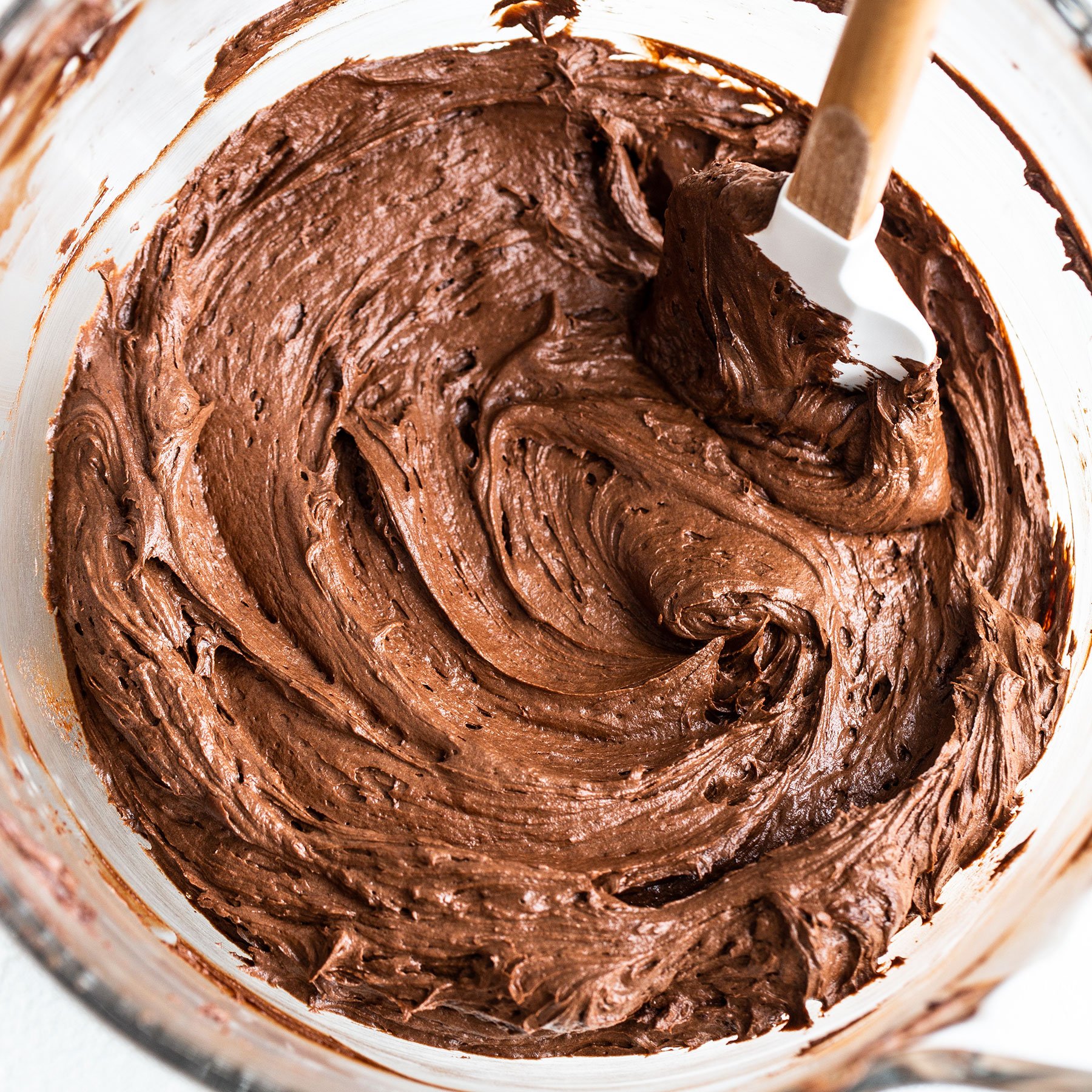
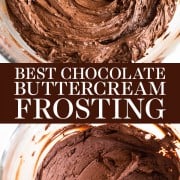
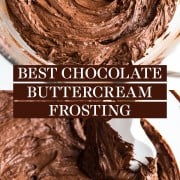
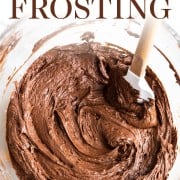
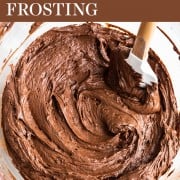


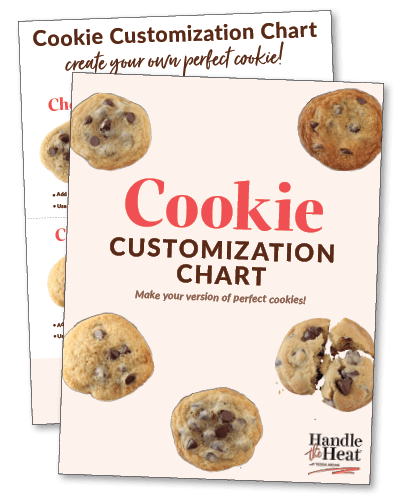
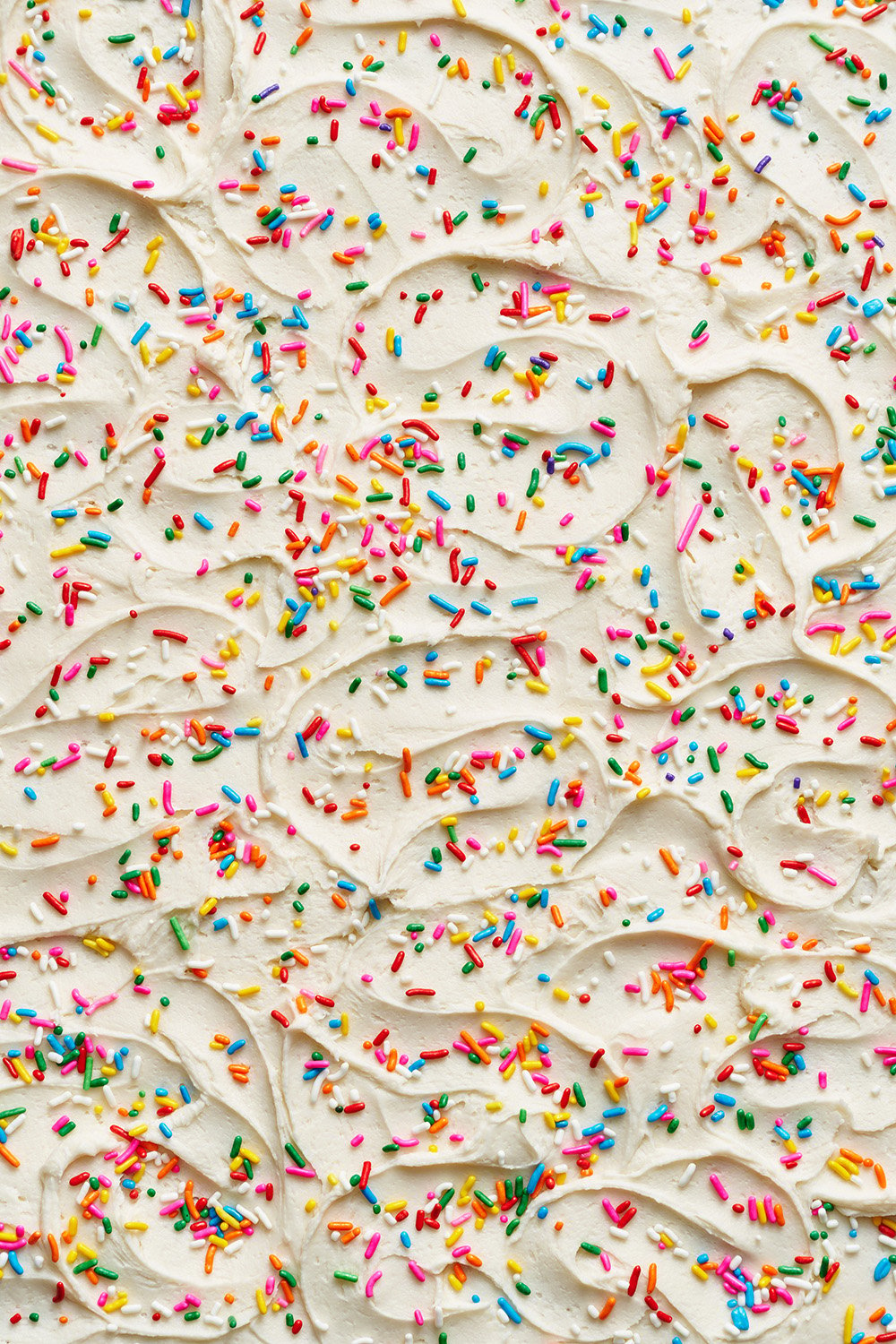
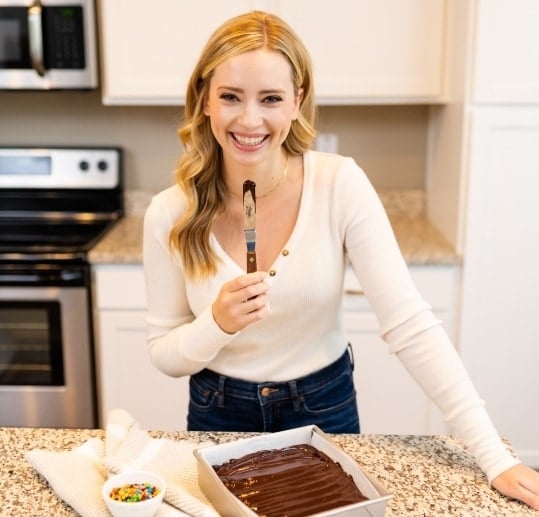

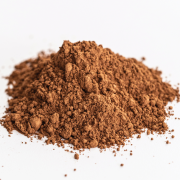
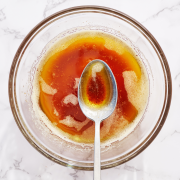
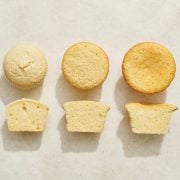
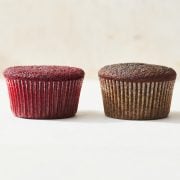
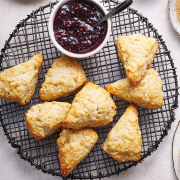
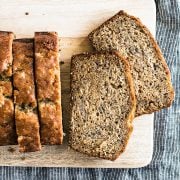
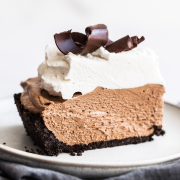
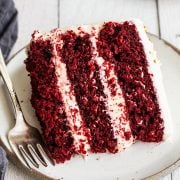








Hi, this is a great recipe! I can’t wait to try it and taste the difference. How can I make this buttercream to stand firm in the heat ?
Thanks!
Hi Audrey! We can’t wait to hear what you think of this buttercream! We haven’t experimented with additions for helping this stand up in excessive heat, but Tessa lives in Phoenix, Arizona, where it’s super hot most of the year, and this buttercream does great in those conditions. For best results, ensure the cake/cupcakes are extremely well-chilled before removing from the fridge and taking where it needs to be served. This way, the cake can slowly warm from its chilled state and prevent it from entirely melting. Be sure to keep it out of direct sunlight. You can also try using half shortening, half butter if the cake needs to sit out for an extended period, as shortening stands up to heat better – but he only drawback here is that shortening doesn’t taste as nice as butter! Let us know how it goes 🙂
When tou mix Butter cream frosting and white chocolate ganache, does this mixture harden to be used under fondant?
Hi Elizabeth! Adding ganache to buttercream won’t harden it much more than a typical buttercream- it’s just enough to give it a deliciously decadent flavor. Refrigerating buttercream will harden it, so you can try icing the cake, chilling it completely until firm, and then covering with fondant. Let us know how it goes 🙂
I should have trusted the recipe note stating this recipe would do a two layer 8inch cake lol. I saw the amount of butter needed and thought, no way. So I doubled it. I always forget that after adding the sugar and cocoa powder in buttercreams makes the volume larger, then adding the ganache on top doubled it again! Now I know for next time. I used some left overs to pipe onto brownies, and have frozen the rest. I haven’t tried the frosting, but mum licked the bowl and is in love, which is saying something because she hates any kind of buttercream! I’m excited to try it with the cake I made tomorrow.
I live in a small community where I don’t have a lot of options with regard to baking items, so I made this with regular icing sugar and a low fat Dutch process cocoa powder, and the icing was still fabulous – by far the best chocolate icing I’ve ever made!
Tessa,
Do you have a go to vanilla buttercream frosting that goes well with the birthday cake?
Hi Maggie! Check out this post with instructions and recipe for an incredible base vanilla recipe, plus a ton of idea on how to customize it for other flavors 🙂
Can I make this frosting ahead of time? And how should I store it? Thanks!
Hi Valerie! As Tessa mentions in the pink tip box above the recipe, “Transfer to an airtight container and store in the fridge for up to a week. Let come to room temperature and re-whip in the stand mixer until light and fluffy again. Add a tablespoon or 2 of powdered sugar if it needs to thicken.” 🙂
can i use the ghirardile dutch process cocoa powder?
Hi Kathleen! Yes, that will be fine 🙂 Let us know what you think once you have given this frosting a try!
Delicious and fluffy. I didn’t put as much vanilla as need (1-1.5 tbp) because I prefer my desserts with less vanilla.
I have been baking for about a year, read and made made recipes of cakes and frostings Love your reasoning and science behind each ingredient. I have a large extended family who are all great bakers who appreciate great food, can’t wait to serve you chocolate frosting.
Looking forward to more of your recipes.
Do you have a Swiss vanilla meringue frosting.
Hi Jerry! We are so thrilled to hear that you’re enjoying learning all of Tessa’s incredible tricks, tips and all about the science of baking! Tessa’s vanilla Swiss meringue buttercream, plus loads more information, can be found here! In case you’re at all interested, I’m also going to include a link to the Waitlist for our Handle the Heat Baking School. Joining the Waitlist means you will be first to know when the doors to the Baking School re-open at the end of this semester. Tessa teaches all about the science of baking, why certain ingredients do what they do, and even how to create your own recipe! Hope to see you inside the Baking School!!
Hi! I love your blog. I live in Argentina and every recipe I make people can’t believe it and ask where did I find it! I have a question. How do you achieve to get a super steady buttercream for warm weather. I use vegetable shortening half and half with butter but I never get a silky texture, always with crumbs from the shortening.
Hi Melisa! I’m so happy you love Handle the Heat’s recipes! That butter/vegetable shortening combination should work well for a more stable and heat-resistant buttercream! Make sure your shortening is at room temperature before it’s beaten with your cool room temperature butter, and ensure you scrape the bowl often, continuing to beat until the shortening and butter is smooth and well combined. I also recommend to pop the buttercream into the fridge for a little bit, if the buttercream starts to get too warm while icing/piping. Chilling the cake layers or cupcakes before decorating, then storing the iced cake/cupcakes chilled (until an hour before serving) also helps! Finally, using something called a High Ratio Shortening can also help a lot with this issue. Check out this article by Sugar & Sparrow for more information on High Ratio Shortening. I hope that helps! Happy baking! 🙂
What a delicious chocolate buttercream frosting!! We all loved it because it wasn’t too sweet. Thank you!
Can you please advise which brand or cocoa is high fat content
Hi Celia! Tessa links three options in the pink box above this recipe 🙂
Can you tell me how to read the fat content information when I look at a can of cocoa?
All I see is on the Total fat line in grams as in 0.5 grams…no % ??
Same with those you’ve listed. Where donyou see the %
Hi Denise! If the label on your cocoa powder doesn’t specify the percentage, then the total fat in grams is fine. You are looking for 1g of fat or more. When you go to the grocery store, turn all the containers around and you should see this listed. Some more specialty stores (such as Penzeys, or online stores) will list in percentages, though. Hope that helps!